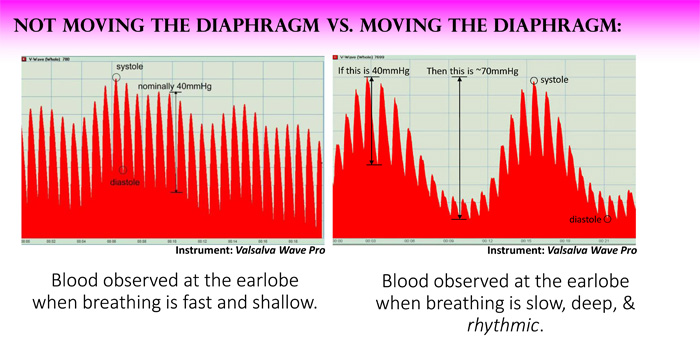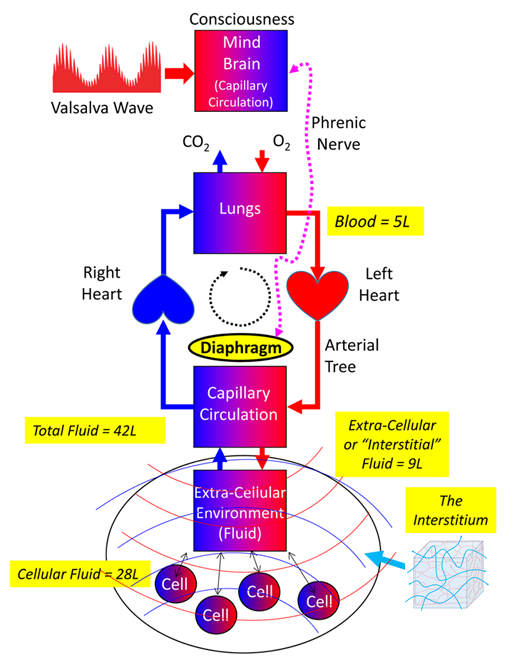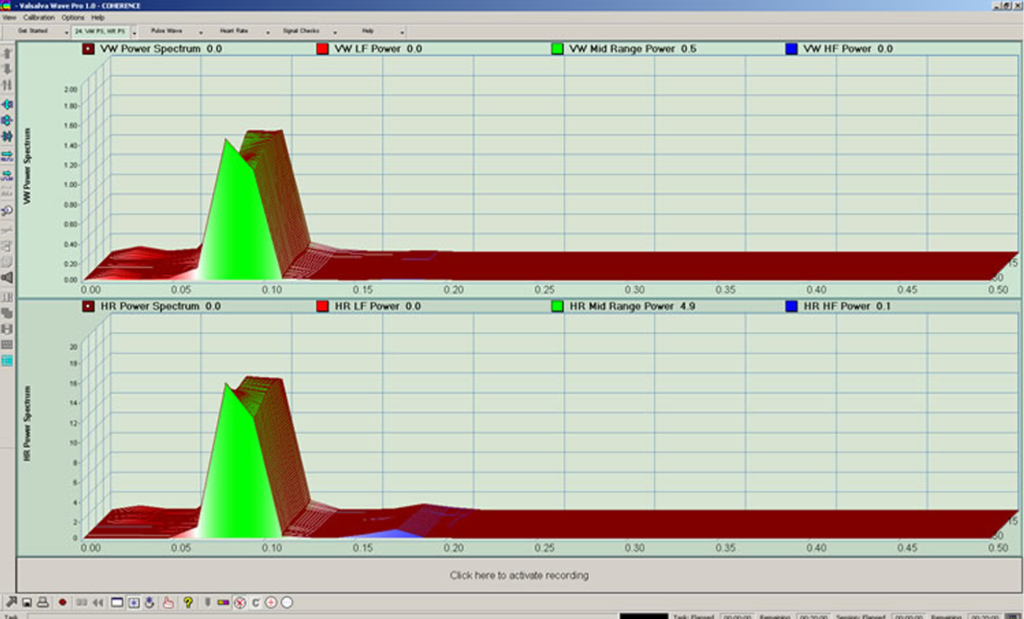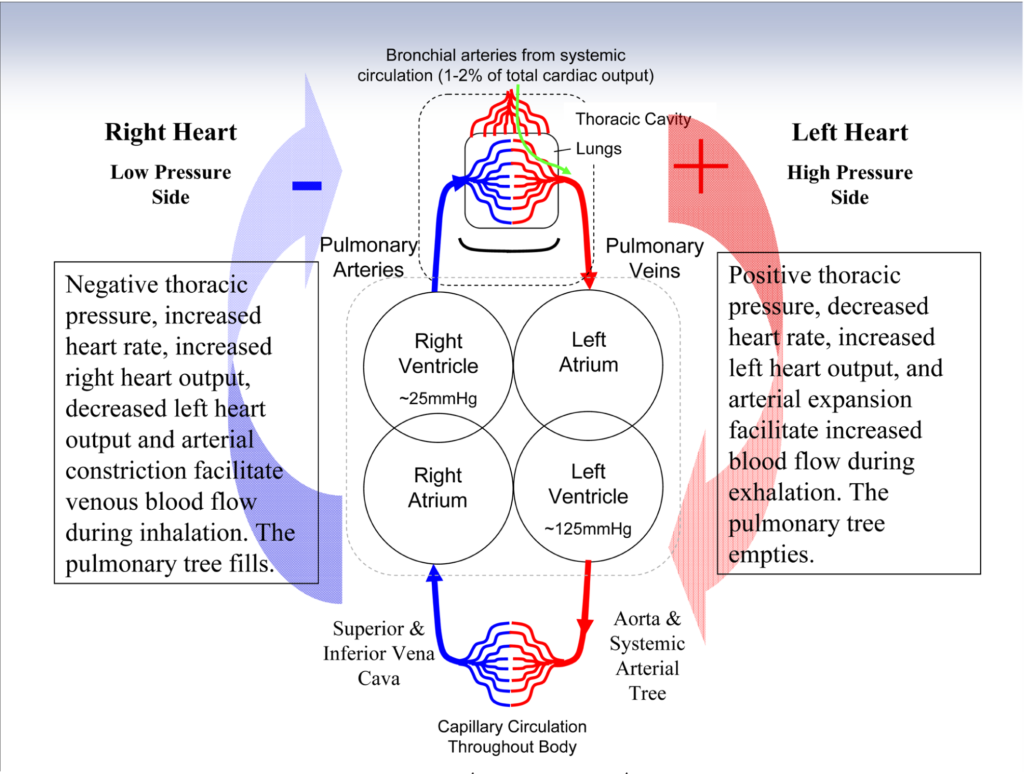Coherent Breathing: Theory & Protocol (6-28-2020)
Please note that Coherence and Coherent Breathing are registered trademarks of COHERENCE LLC.
Introduction
The term “Coherent Breathing” was coined by Stephen Elliott, circa 2004, upon launching COHERENCE LLC and acquiring the coherence.com and coherentbreathing.com domains. The trademark was filed in November of 2005. Coherent Breathing describes both a breathing method and a means of internal state management, this being: learning to both breathe at the nominal rate of 5 breaths per minute with equal periods of inhalation and exhalation AND conscious relaxation of “The Six Bridges”, the 6 anatomical zones of the body over which we have explicit dual control, technically, 12 muscle groups. This is made clear in The New Science Of Breath, chapter 1, published in December, 2005.
This formula: Breathing at ~5 breaths per minute + relaxation of “bridges”, was discovered while searching for a protocol that would reliably elicit the Awakened Mind (EEG) brainwave pattern. (Awakened Mind is a trademark of the late Anna Wise.) Via personal practice with multiple simultaneous forms of biofeedback over several years, Stephen was able to arrive at this definition of the protocol, eventually spending an afternoon with Anna Wise at her office north of San Francisco where she validated the Awakened Mind brainwave pattern using Mind Mirror.
In summary, it is posited that the wholistic Coherent Breathing “system” facilitates the Awakened Mind brainwave pattern. The current theory is that this is an outcome of: a) the Valsalva Wave as seen by the brain – a result of breathing at the nominal rate of resonance with equal periods of inhalation and exhalation and moving the diaphragm so as to emulate a sine function, e.g. a pendulum, and b) the internal letting go (relaxing) of everything that is within our conscious power to-let-go. These aspects, when practiced together, set up and sustain wave action in the circulatory system, this wave action thought to be the primary impetus for arisal of the Awakened Mind EEG pattern in the brain. In the 2010-2013 time frame, via different simultaneous experiments we established that the brain does in-fact experience a wave of blood that is produced by breathing, i.e. the action of the lungs, as a consequence of the action of the diaphragm, as a consequence of the phrenic nerve, as a consequence of neural action, either somatic or autonomic, where the diaphragm is the foremost “bridge” – without it mammalian life would not have survived long in this world.
This explanation describes how Coherent Breathing came to be, this not being explained openly until 2014, after Anna Wise’s passing in 2010. EEG practitioners, most notably colleague Dee Edmonson, RN, BCIAC-EEG, dating back to 2001, witnessed the immediate “positive” effect Coherent Breathing has on blood pressure, EEG, HRV, hand temperature, and skin conductivity. Since its announcement in 2005, we’ve learned so much more about the broad impact Coherent Breathing has on human health and well-being.
I urge you to revise your paradigm. Instead of thinking of breathing as a gas exchange function, please consider it this:
“Breathing Is A Circulatory Function During Which Gas Exchange Occurs.” (SE)
My research of 20 years brings me to this fundamental conclusion. By thinking of breathing in this way, then we can clearly comprehend its importance. By thinking of “breathing as a respiratory function” we cannot. I challenge the reader to search on the term “human circulatory system” and see if you can find an instance where the lungs are included as an active aspect of circulation. It is an absurd omission – if it were not for the contribution of the “thoracic pump” to circulation, it would be impossible to exercise. The reason we must breathe when we exercise is that cellular energy production demands fluid exchange, and of course gas exchange, hence more blood flow, and more effective fluid exchange throughout the body, e.g. the necessity for wave action.

Protocol:
2016 was an important year for The New Science Of Breath. In 2016 we published Personal Resonance Protocol which defines the essential method used to determine “personal” resonant frequency using Valsalva Wave Pro – which monitors the “Valsalva Wave” and Heart Rate simultaneously, and revised Valsalva Wave Pro to Release version 2.0, optimizing it to support the quest for “personal resonance”.
During this research, the real importance of “sinusoidal diaphragm movement” emerged, in that sinusoidality is an important physical characteristic of resonance – throughout nature, and in the human body. This confirmation led to our first formal change to the Coherent Breathing method since the publication of The New Science Of Breath, second edition in 2006, this being “that diaphragm motion should be sinusoidal”, the pendulum analogy, as used in The New Science Of Breath (2006) being accurate but without specificity. Consequently, the formal definition of Coherent Breathing (without biofeedback) is revised to:
1. Breathing at the nominal rate of 5 breaths per minute with equal periods of inhalation and exhalation. (As articulated in The New Science Of Breath, 2006, and RESPIRE-1 (2005).
2. Conscious relaxation of “bridges”, specifically during exhalation, the parasympathetic swing of the pendulum. (As articulated in The New Science Of Breath and as supported by The Six Bridges CD.)
3. Diaphragm motion should be sinusoidal. This means that the motion should emulate the action of the pendulum, i.e. accelerating, decelerating, reversing, accelerating, decelerating, reversing, etc. A harp string is also an accurate analogy, as its motion is also sinusoidal. This can be best understood by observing the action of a sine wave in motion.
4. Practice 20 minutes per day for 3 weeks, preferably with RESPIRE-1 Vocal Instructive Sequence.
5. The formal breathing biofeedback instrument that supports Coherent Breathing is Valsalva Wave Pro, where its use has a protocol of its own.
End.
Having discovered and adopted my own personal resonant frequency, and having felt and witnessed its profound effect on my own health and appearance, I took a deep dive into circulatory physiology, this to understand “Why?”
In a nutshell, I learned (what is already documented in Medical Physiology), that the average adult body contains ~42L of fluid, 5L of blood (12%), the remaining 88% comprising fluid contained in the trillions of cells in the body, “intracellular fluid” accounting for ~28L (66%). Cells float in an aqueous environment known as the extra-cellular environment, “extra-cellular” fluid accounting for ~9L (21%). Specialized fluids such as cerebrospinal fluid, lymph, etc., make up the remaining 1-2%. (Source: Medical Physiology, Guyton & Hall, 2002.)
The punch-line is that while blood only comprises 12% of body fluid, the remaining 88% of fluid in the body depends on the action of blood to flow – and the action of blood depends on the action of the diaphragm…of breathing. When we are breathing with depth and rhythmicity, a wave develops in the circulation, flow rising in the arterial tree during exhalation and rising in the venous tree during inhalation. We’ve named this wholistic arterial/venous wave the Valsalva Wave. This because Antonio Valsalva was one of the first Western observers of the relationship between breathing and blood flow (in his dogs). It turns out that Antonio Valsalva lands nicely on “arterial” followed by “venous”, A followed by V. Please note that Traditional Chinese Medicine had recognized the relationship between breathing and blood pressure 2500 years earlier, as documented in the Yellow Emperor’s Classic On Chinese Medicine.
Stephen Elliott has been writing articles about Coherent Breathing since 2006. Please view the "Articles" menu.

Figure 1: The Valsalva Wave As Viewed At The Earlobe,
The Motive Force That Facilitates Flow Across The Capillary Membrane.
The Wave Rises During Exhalation And Falls During Inhalation.
Figure 1 presents the complex phenomenon of the Valsalva Wave as viewed at the earlobe, a wave that is composed of both respiratory wave, i.e. resulting from diaphragm movement, and the heart beat. The breathing induced wave is the slow wave that can be seen by connecting the dots between cardiac diastoles. The heartbeat rides atop the respiratory wave, blood volume of each heart beat increasing as the underlying wave rises and decreasing as the underlying wave falls. Heart rate also slows down and speeds up in synchrony with the rise and fall of the respiratory wave, respectively. The Valsalva Wave and heart rate function this way to facilitate venous return during inhalation (very low pressures involved), and arterial flow during exhalation (much higher pressures).
We have seen instances where no wave action exists at all, i.e. both Valsalva and HRV are “flatlines”, and we’ve seen cases where both Valsalva Wave and HRV are completely chaotic.

Figure 2: The Action Of The Blood When Breathing Is Fast And Shallow Vs. Slow, Deep, & Rhythmic
Figure 2 compares Valsalva Wave action of Coherent Breathing (right) and “incoherent breathing” (left). Peak-peak amplitude (pressure) on the right is estimated at 70mmHg. That on the left is approximately 40mmHg, the normal difference between cardiac systole and diastole, i.e. 120/80, the difference between the two being 40. As flow correlates with pressure, the Valsalva Wave of Coherent Breathing facilitates 1.75 times the flow of “incoherent” breathing. In theory, this flow refers to all fluids in the body as will be described.

Figure 3: The Valsalva Wave Rising And Falling In The Medial Cubital Vein.
The Wave Falls During Inhalation And Rises During Exhalation.
Referring to Figure 3, the reason the wave in the venous circulation falls during inhalation is that when we inhale, it generates a relative vacuum in the lungs, to which venous blood is drawn, blood volume in the venous tree dropping. At the same time, heart rate and left heart ejection fraction fall, decreasing pressure and flow at the capillary circulation. Right heart ejection fraction increases in order to shuttle blood from the vena cava into the lungs in equal measure to that previously ejected by the left heart, thereby facilitating circular flow, ergo “the circulation”.

Figure 4: The Capillary Membrane - The Means By Which Nutrition And Hydration Reaches Cells.
Arteries and veins branch 6-8 times before supplying the capillary bed of the organ. The capillary membrane is microscopic, having a nominal width of 200 millionths of an inch, barely large enough for 1 red blood cell to squeeze through at a time. It is pervasive throughout the body, so as to supply the ~100T cells with hydration, nutrition, and gas exchange. It is surrounded by the interstitium, a porous construct that provides form to the body, filling all empty spaces around cells and facilitating flow between cells and the capillary membrane. (Reference: Medical Physiology, Guyton & Hall, 2002).
Coherent Breathing: The Thesis
I’m sure you comprehend the significance of this theory…the integrity of the cellular environment of the body, and consequently the intensity of cellular health, depends on variations in blood flow and pressure, which depend on: a) the heart beat, and b) diaphragm movement. I am particularly interested in both long and short term effects of breathing well vs. not breathing, on the brain and brain function, this being due to the fact that when are erect, the body becomes a column of fluid, subject to gravity. When we are erect inhalation vacuums blood from the feet and legs (and assists gravity in moving blood from the head and brain) to the chest, and exhalation sends blood to the brain (and assists gravity in sending blood to the legs and feet). We can see immediate changes in the amplitude of brain waves with a single cycle of Coherent Breathing.
In the research behind the paper of 2013 titled Breathing, Blood Flow, & The Brain, we found that Coherent Breathing at the nominal rate of 5 breaths per minute elicited brainwaves with amplitude 10 times higher than functional brainwaves, delta, theta, alpha, and beta, and that presence of these waves correlated with the presence of the Valsalva Wave as detected at the earlobe.
These large low frequency waves had not been identified via EEG because they were filtered out in the early days of EEG, considered “unwanted physiologic noise”. EEG instruments to follow also implemented this low frequency filtering, this so functional waves could be observed without the interference of breathing induced brainwaves. This same low frequency filtering was applied by leading Heart Rate Variability instrument producers, and it made sense, since they were targeting the EEG practitioner market space. Anyway….
The study also employed hemoencephalography with low frequency filtering removed, and there again we found the presence of the Valsalva Wave in the brain and its correlation with the wave as observed at the earlobe as detected with Valsalva Wave Pro. This understanding changed everything we know about breathing and its effect on heart rate. Now we must acknowledge that resonant breathing sends a large wave of blood to the brain and that the brain responds instantaneously by producing large electrical signals that correlate with the action of the blood as seen at the earlobe. The bottom line is that Coherent “resonant” breathing has a huge and direct effect on the brain via the action of the Valsalva Wave washing through the brain with every cycle of inhalation and exhalation, where shallow irregular breathing produces little to no wave at all. All the brain sees is a steady heartbeat.
The mistake is that over 50 years low frequency filtering was forgotten about as was the importance of breathing to these schools of science. Now we know that resonant breathing produces the brainwave patterns of interest in the first place. (We witnessed them by taking low frequency filtering out of EEG, HEG, and HRV instruments.)
Once again, based on this understanding, I urge you to revise your paradigm. Instead of thinking of breathing as a gas exchange function, consider it thus:
"Breathing is a circulatory function during which gas exchange occurs, where every cell in the body depends on it for hydration, nutrition, waste removal, and gas exchange."
Coherent Breathing promotes the use of consciousness to control the diaphragm vs. turning breathing completely over to the autonomic nervous system, in which case breathing often ends up in the weeds, i.e. short, shallow, and chaotic. Conscious use of the phrenic nerve over rides autonomic action. For this reason, even if we are in ice water, consciousness can over rule autonomic emphasis which would have us breathe in a panic mode. Ice water is an extreme example of autonomic reaction and what it does to breathing. Everyday life is filled with worry, insult, and injury that, depending on our reaction, would also have us breathe in a short, shallow, chaotic manner, sympathetic vs. parasympathetic emphasis. Conscious use of the phrenic nerve and diaphragm aids us in managing our experience of, and reaction to life.
This is the wholistic perspective on breathing, where my spelling of “wholistic” is intentional.

Figure 5: Coherent Breathing Model Of Cardio-Pulmonary-Circulatory System
The present understanding of resonance is where the action of the blood (The Valsalva Wave) and the action of the heart (Heart Rate Variability) are nominally 180 degrees out of phase. The time domain view looks like this:

Figure 6: Time Domain View Of Resonance Viewed At The Earlobe.
Red Is The Valsalva Wave And Blue Is The Heart Rate.
Here we can see the action of the blood preceding the action of the heart by about 1 second. This is because the action of the diaphragm and consequent action of the blood is the determinant of the heart rate. As the Valsalva Wave rises (exhalation) heart rate falls. As the Valsalva Wave falls (inhalation), heart rate rises. The bottom panel exhibits “resonance” where the purple line is the correlation coefficient of the Valsalva Wave (red) and Heart Rate (blue). Here we can see that it approaches -1, near 180 degree phase alignment.

Figure 7: Frequency Domain View Of Resonance.
The Top Panel Is Valsalva Wave Spectrum And The Bottom Panel Is Heart Rate Spectrum.
Referring to Figure 7, the frequency domain view looks like this, where we can see that the Heart Rate and the Valsalva Wave are locked in frequency.

Figure 8: Fundamental Cardio Pulmonary Circulatory System.
Referring to Figure 8, when breathing approaches the resonant rate and depth, the diaphragm shares the burden of circulation with the heart. Whereas when breathing is rapid and shallow, the heart takes the burden of circulation, specifically the burden of venous circulation, which is fundamentally the responsibility of the diaphragm.
Blood flows in a circle – it flows from the lungs through the left heart to the capillary circulation upon exhalation and from the capillary circulation through the right heart into the lungs upon inhalation. If the diaphragm does not move downward adequately with inhalation, then the venous tree remains full and capillary blood flow is stifled. When capillary blood has nowhere to go, arterial blood backs up. If arterial blood backs up, the autonomic nervous system increases the pressure to facilitate arterial flow. This is the crux of hypertension, i.e. blood does not flow in a circle freely because the diaphragm is not moving downward adequately, such that the venous tree empties into the lungs. Instead the burden of venous return falls to the right heart, a pathological scenario.
Cellular health throughout the body is jeopardized – by not breathing with adequate depth and rhythmicity. This is because there is no wave action across the pervasive capillary membrane to facilitate positive and negative pressure and consequent flow.
We hypothesize that this is particularly true for the brain because it is held above the chest and is dependent on the wave action generated by the diaphragm for “healthful” circulation. We must also ask about brain function itself when breathing “coherently” vs. breathing without depth and rhythmicity…
Because we are erect beings when we’re not lying down, can the brain work optimally, much less properly, when we are not breathing with depth and rhythmicity? What are the long term consequences to brain health? What does it mean to human consciousness? These are important questions that deserve research.
From the time we developed Valsalva Wave Pro, we wanted to instrument a giraffe, this because it would show categorical proof that the brain depends on diaphragm movement for blood flow. We got such an opportunity in January of 2017 when The Dallas Zoo invited me to instrument a giraffe that was due to have her hooves trimmed. You can find the article detailing this event here. The bottom line is that all one sees in the head of the giraffe is blood waves as a consequence of diaphragm movement – the heart beat is barely visible by comparison.
